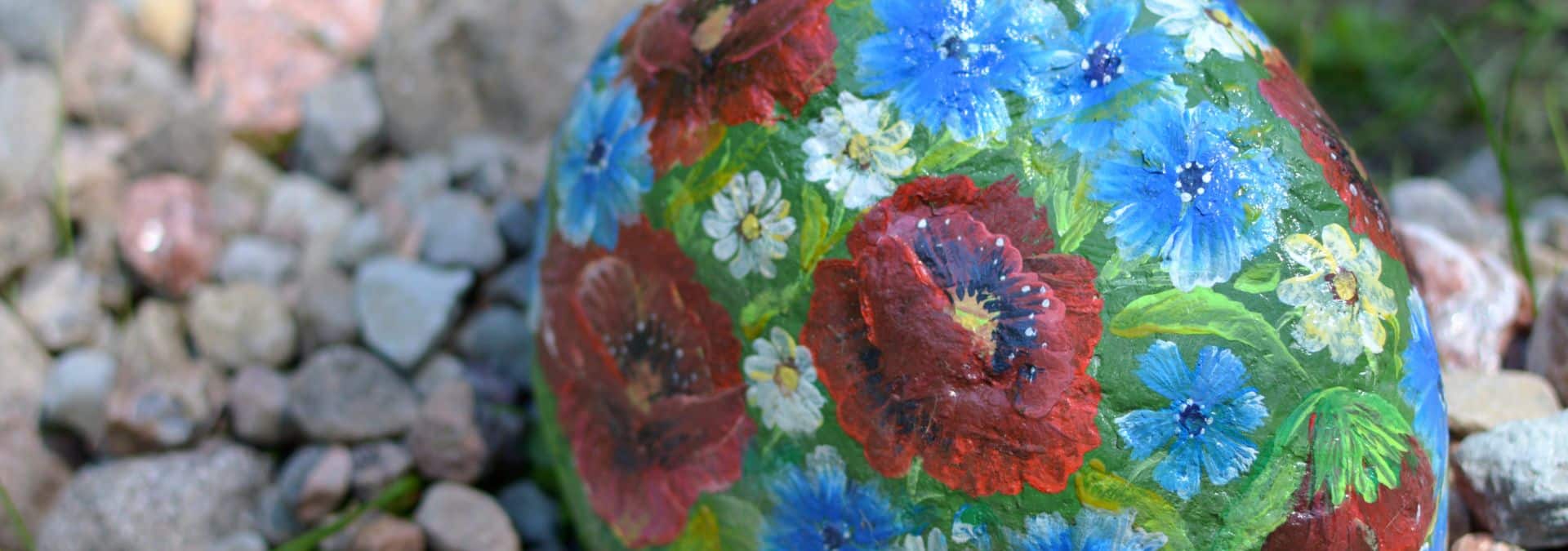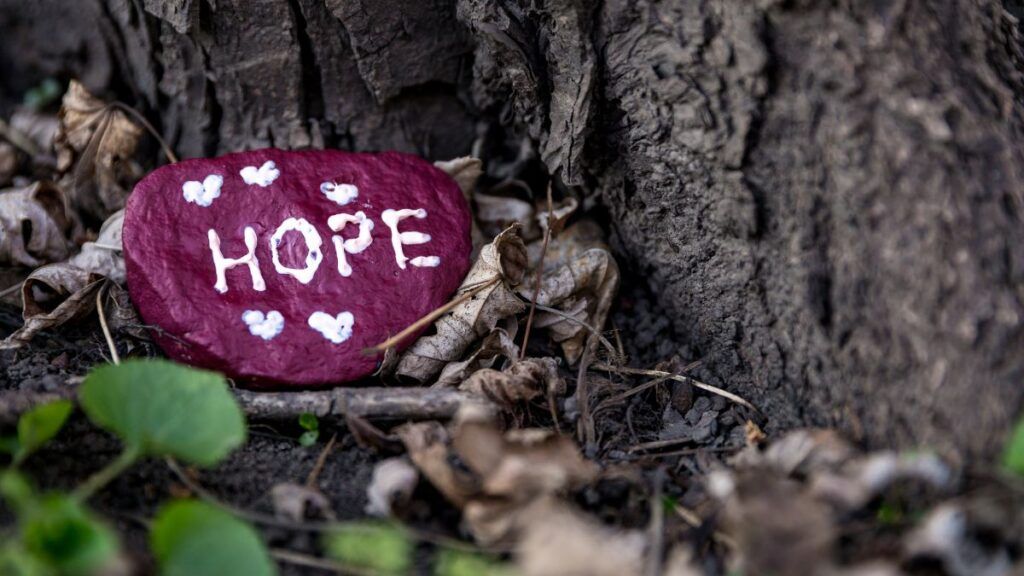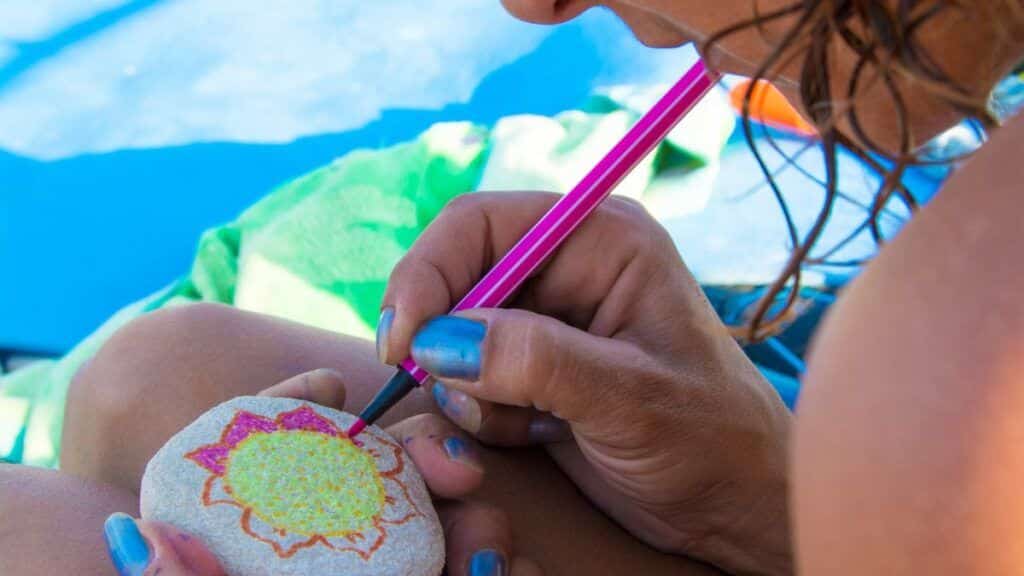Found a Painted Kindness Rock While Camping? (What To Do)

Have you found a painted kindness rock while camping or hiking? They are meant to spread kindness, but sometimes they break the rules. Here’s what you need to know…
There’s a trend spreading across campgrounds where people paint rocks and leave them for others to find. They often paint a happy design or write encouraging words, earning them the name “kindness rocks.”
This trend spawned from a national campaign called The Kindness Rocks Project®. It’s meant to inject a little joy or inspire those who find them.
Another version of this trend is “hide and seek rocks” or “traveling rocks” where people who find a rock are supposed to hide or leave the rock elsewhere. There’s usually a hashtag or website written on the back to track its journey.
It’s fun to participate in these trends, and we will tell you how at the end of the article. However, it’s also very important to understand WHEN IT’S NOT OKAY to leave painted rocks.
If you buy something through our links, we may get a small commission at no extra cost to you. It helps keep our lights on so we can continue to provide helpful resources for RVers. Read our full affiliate disclosure here.
The Good Intentions of Rock Painting
If you visit The Kindness Rocks Project website, you’ll see the well-intentioned mission behind the project. It’s meant to spread mental health awareness and connect people in a positive way.
“Traveling rocks” and “hide and seek rocks” are also meant as a fun way to connect people from all over the world through a simple medium. It teaches us how a small act can positively impact countless people.
The kindness, connectivity, and joyful aspects have certainly catapulted rock painting into a full-fledged hobby for kids and adults alike.
However, it’s very important that we understand that these good intentions can sometimes have negative consequences…
The Problem of Painted Rocks
As campers, we must be particularly mindful of how painted rocks can negatively affect the environment. There is a “Leave No Trace” policy at BLM, state, and national parks for a reason, and painted rocks clearly violate that policy.
The policy also states that you shouldn’t remove any rocks from the parks. So, “rock hunting” in a state or national park is a no-no.
Even if you use environmentally safe paint on the rocks, the colors and designs can disrupt an ecosystem. Birds and fish, in particular, can be thrown off by the foreign objects, disrupting their eating, nesting, and mating behavior.
You can learn why Leave No Trace was implemented on the organization’s website.
The painted rocks also pose a serious risk to hikers. People have mistaken painted rocks for trail markers, causing them to unwittingly go off trail. As we all know, losing a trail is one of the biggest dangers of nature activities.

Where Can You Leave Painted Rocks?
The Kindness Rock Project never encouraged people to leave rocks out in nature. You can see examples of designated rock gardens and how people have incorporated them into their residential landscaping.
So, creating a painted rock garden on your property is ideal. Or, you can get permission from the proper authorities to create a rock garden at a local park, playground, school, business center, etc.
In short, consider painted rocks as part of landscaping, not nature.
Can You Leave Painted Rocks at Campsites?
If you stay in an NPS or other public land campsite, the answer is a definitive “No.” No matter how skilled your artistry is, painted rocks are considered litter on public land and can result in a hefty fine.
However, some private campgrounds allow (and some even encourage) painted rocks to be left on their property. But this is entirely at the discretion of individual campgrounds. You must check with management and their policies.
What To Do If You Find a Painted Rock on Protected Land

If you find a painted rock on public land (i.e. national park, state park, BLM land), you should remove it if and only if it was clearly painted and left by a citizen. A brightly colored rainbow rock with butterflies, for instance, clearly doesn’t belong in the wild.
If you are unsure whether or not a painted rock should be there, it’s best to leave it there. As mentioned, rocks are sometimes used to mark trails and you certainly don’t want to touch those. But trail rocks are usually marked (if marked at all) with a simple line or arrow… not an arts and crafts design.
If you are compelled to contact the rock owner and admonish them, please do it nicely. Remember, these rocks are meant to spread kindness and joy. The rock-leaver had good intentions and may not have known they shouldn’t leave it on public land.
Also, remember, many rock painters are children! So, we recommend responding in kindness with something like:
“You did a lovely job painting this rock. It brought a smile to my face, but then I remembered we are not supposed to leave painted rocks at (national parks, etc.). They can harm the ecosystem and put hikers in danger. So, I’m giving your pretty rock a new home…”
What To Do If You Find a Painted Rock at a Campground?

If you find a painted rock or kindness rock at a private campground or campsite, join the fun! If the campground allows them, it really is a great way to connect with other campers and people from around the world.
If the rock has a “kindness” message, you can take a picture and share it on any social media platform using the hashtag #thekindessrocksproject.
Some rocks also come with instructions on the back. Some instruct the finder to “keep” or to “rehide.” And some come with a hashtag, website, phone number, or another way to share your discovery.
Simply follow the instructions on the rock to spread the joy and kindness. If you don’t have wifi or cell service, snap a picture of the rock and share it later.
If you want to paint your own rock, use non-toxic paint and markers. You can collect rocks on approved property or buy a box of rocks that are flat and smooth and perfect for painting.
If you like arts and craft, check out the 13 Best Travel Crafts & Activity Books for Adults.
Don't Leave a Footprint When Boondocking
Like what you see in these videos? We'd appreciate it if you would Subscribe to our YouTube Channel (easy to do right here) and consider “ringing the bell icon” to be notified of any new video from us. 🙂 Thanks!
When boondocking, you always want to leave a site exactly how you found it. Regardless if you're in a national park or not, the best etiquette is to Leave No Trace wherever you go.
In this video, we remember our ecological footprint while camping, chat about our boondocking experiences, and discuss the wonderful community over at the Escapees RV Club.

This ebook is a seven-stop guided exploration of the Michigan UP. We provide a suggested route and itinerary, links to multiple campgrounds and boondocking spots, and the best spots to see along the way. Don’t plan your trip to the Upper Peninsula without it!
RV Lifestyle Favorite Amazon Quick Links
If you buy something through our links, we may get a small commission at no extra cost to you. It helps keep our lights on so we can continue to provide helpful resources for RVers. Read our full affiliate disclosure here.
